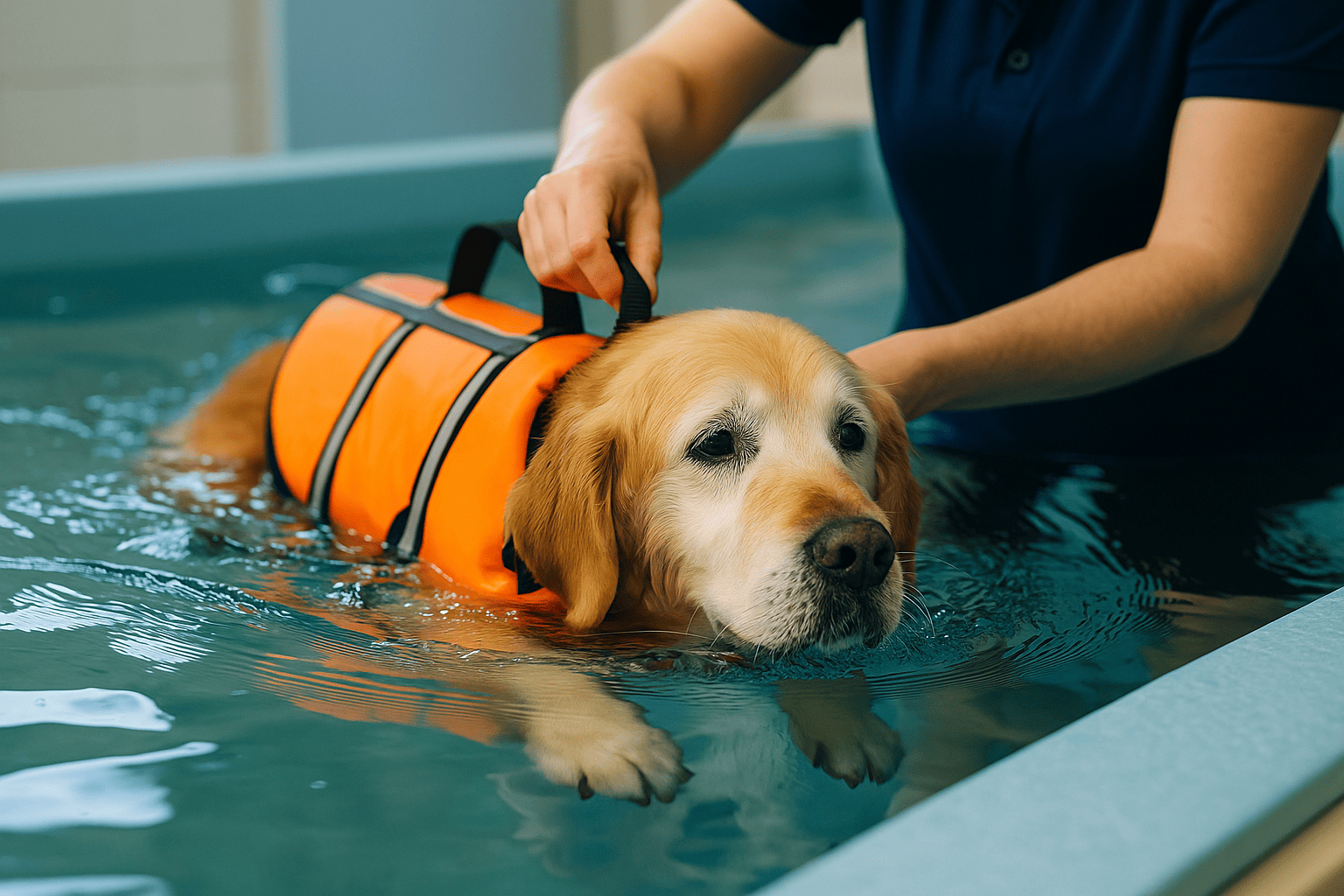Discover how therapeutic swimming can help senior dogs with arthritis relieve pain, improve mobility, and regain quality of life — safely and effectively.
A Gentle Path to Relief and Mobility
Arthritis is a common condition in dogs, especially as they age. It causes joint inflammation, stiffness, and pain, making everyday activities like walking or getting up increasingly difficult. Just like in humans, canine arthritis can significantly reduce a dog’s quality of life.
Among the many treatment options, therapeutic swimming has emerged as a safe, effective way to help dogs with arthritis stay active and feel better. This low-impact exercise strengthens muscles and relieves joint pressure, helping dogs move with more ease and less pain.
What Is Therapeutic Swimming for Dogs?
Therapeutic swimming, also known as canine hydrotherapy, is a type of aquatic physical therapy designed to support dogs recovering from injuries or managing chronic conditions like arthritis. Unlike recreational swimming, therapeutic sessions are planned and supervised to ensure the movements are both safe and beneficial.
These sessions usually take place in specialized facilities equipped with temperature-controlled pools, ramps, and safety gear such as canine life vests. Trained professionals guide the exercises based on each dog’s condition, ensuring personalized and effective care.
For pet parents who prefer at-home options, swimming can also be done in a controlled domestic environment. However, it’s essential to maintain proper water temperature and always consult a veterinarian beforehand to ensure the activity is suitable for your dog’s specific needs.
Benefits of Swimming for Dogs with Arthritis
Therapeutic swimming offers a range of physical and emotional benefits for dogs with arthritis:
Pain and Inflammation Relief
Water provides natural buoyancy, which reduces the pressure on joints and allows dogs to move without the pain caused by ground impact. This immediate relief can help ease inflammation and make movement more comfortable.
Muscle Strengthening
As dogs swim, they work against the resistance of water, which helps strengthen muscles without straining the joints. Since arthritic dogs often lose muscle mass due to inactivity, swimming is a safe and effective way to rebuild strength and support joint stability.
Improved Mobility
Swimming enhances joint flexibility, allowing dogs to stretch and move more freely. Over time, regular sessions can restore a greater range of motion and help dogs walk, climb stairs, or play with less difficulty.
Weight Management
Keeping your dog at a healthy weight is critical for managing arthritis. Swimming helps burn calories and maintain physical activity, all without putting stress on painful joints. This reduces additional strain and improves overall comfort.
Important Safety Guidelines for Therapeutic Swimming
While swimming is a powerful tool for managing arthritis, it must be done with care. Follow these key safety tips:
Veterinary Supervision
Always talk to your vet before starting hydrotherapy. A full health check will help determine if swimming is appropriate, how often sessions should occur, and any limitations that should be respected to avoid aggravating the condition.
Use Specialized Pools
Therapeutic pools designed for dogs offer warm water, easy access, and experienced staff who understand the needs of arthritic pets. These facilities provide a safer and more controlled environment than backyard pools or lakes.
Water Safety Measures
Dogs with arthritis may have reduced strength or coordination. Life vests are strongly recommended, especially for beginners. Water temperature should stay between 82–90°F (28–32°C) to soothe muscles and avoid cold-related discomfort.
Session Frequency and Duration
Start with short sessions of about 10–15 minutes, gradually increasing as your dog adapts. Most dogs benefit from swimming two to three times per week. Watch your dog closely during and after sessions, and adjust based on their comfort and response.
When Swimming May Not Be Appropriate
Although swimming is generally safe, it may not be suitable in certain situations:
- Severe health conditions such as heart disease or respiratory problems
- Open wounds or skin infections
- Advanced arthritis causing extreme pain with movement
If your dog shows signs of extreme fatigue, confusion, or unusual behavior during or after swimming, stop the activity and consult your veterinarian.
Recognizing Signs of Discomfort During Swimming
Always monitor your dog closely while in the water. Watch for:
- Excessive panting
- Shivering
- Trouble staying afloat
- Stiffness or reluctance to move
These may signal that your dog is overexerting or experiencing discomfort. Pause the activity and let them rest if any of these symptoms appear.
Success Stories: Real-Life Improvements
Many pet parents and veterinarians have seen positive results with therapeutic swimming. After a few sessions, dogs often show:
- Reduced stiffness
- Better movement and energy levels
- Increased willingness to play or go for walks
In some cases, dogs who struggled to climb stairs or go on long walks regained those abilities with regular hydrotherapy. Strengthening muscles and reducing joint impact leads to a happier, more active life.
Conclusion
Therapeutic swimming is a gentle and effective way to support dogs with arthritis. It helps manage pain, build muscle, improve flexibility, and control weight—all without adding stress to sensitive joints.
However, professional guidance is essential. Always consult your veterinarian and follow proper safety protocols. With the right support, swimming can become a life-changing part of your senior dog’s care routine.
If your dog suffers from arthritis, consider exploring therapeutic swimming. It could be the key to helping your furry friend move more comfortably and enjoy life again.

